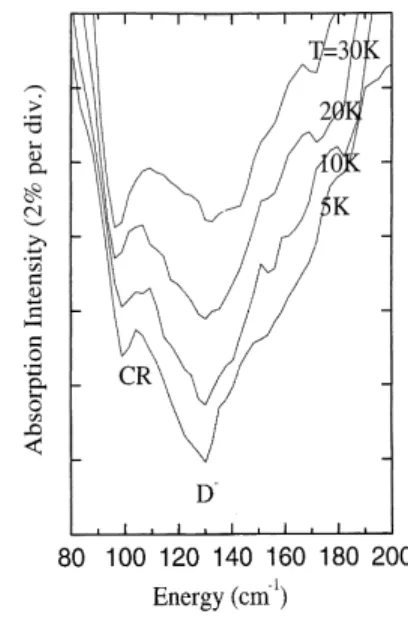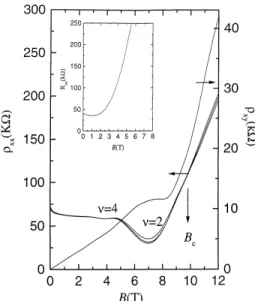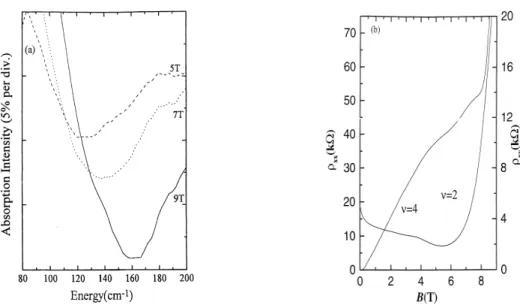Transport and Optical Studies of the D
¡-Conduction Band in Doped
GaAs/AlGaAs Quantum Wells
C. H. Lee1, Y. H. Chang1, C. F. Huang1, M. Y. Huang1, H. H. Lin2, and C. P. Lee3
1Department of Physics, National Taiwan University, Taipei, Taiwan 106, R.O.C. 2Department of Electrical Engineering, National Taiwan University, Taipei, Taiwan 106, R.O.C.
3Institute of Electronics, National Chiao-Tung University, Hsin-Chu, Taiwan 300, R.O.C. (Received March 23, 2001)
The properties of D¡ ions in quantum wells were studied. It is found that, with an intermediate concentration of D¡ ions, electrons in the quantum wells possess both band-like and impurity-like properties. The appearance of the Quantum Hall effect makes it possible to rule out the existence of an impurity band that is separated from the conduction band. The results are interpreted in terms of the formation of a D¡ conduction band, with the D¡ band becoming a tail of the conduction band. The implications of our experimental results on the metal-insulator transitions in doped semiconductors are discussed.
PACS. 71.30.+h – Metal-insulator transitions and other electronic transitions. PACS. 73.20.Jc – Delocalization processes.
PACS. 71.55.Eq – III-V semiconductors.
The electron-electron interaction is of fundamental importance to the transport properties of an electronic system. It is widely believed, for example, that the electron-electron interaction is responsible for the unexpected observation of metal-insulator transitions in two-dimensional systems at zero magnetic field [1]. The electron-electron interaction also plays an important role in Mott’s theory of metal-insulator (M-I) transitions in doped semiconductors [2]. In Mott’s theory, the electron-electron interaction creates an energy gap, known as the Hubbard gap, between the one-electron donor state (D0 state) and the two-electron donor state (D¡ state). As the donor concentration increases, the one-electron and two-electron donor levels broaden into the lower and upper Hubbard bands, or D0 and D¡ bands. M-I transitions occur when the two Hubbard bands merge and the Hubbard gap disappears. The existence of a two-dimensional D0band was first observed in Si metal-oxide-semiconductor field effect transistors and its properties were studied in detail. Attempts had been made to observe the D¡ band in the same system, with no success [3].
The advance in crystal growth has now made it possible to easily create D¡ ions in a quantum well, and thus offers the possibility of studying the properties of the D¡ band. By doping the quantum wells and the barrier layers selectively with an n-type dopant, several groups had reported the observation of D¡ ions in GaAs/AlGaAs multiple quantum wells (MQWs) [4]. These D¡ ions are created because the donors in the QWs can capture electrons released from the donors in the barriers and become negatively charged. By increasing the concentration of D¡ ions
364 TRANSPORT AND OPTICAL STUDIES OF THE¢¢¢ VOL. 39
in the quantum well the isolated D¡ level is expected to broaden into aD¡ band. In this letter we report the study of transport and optical properties of samples with different D¡ concentrations in GaAs QWs. For the low concentration sample, isolated O- behavior was observed. For the samples with higher concentration, it is found that the sample exhibited conduction band and D¡ band behavior simultaneously. The quantum Hall (QH) effect, a property of the conduction band, was observed in the magneto-transport measurement; and at the same time, a D¡-related transition, a property of the D¡ band, dominated the spectral response of the sample. The experimental results are interpreted as the formation of a D¡-conduction band. Its implication on M-I transitions in doped semiconductors is also discussed.
The multiple quantum wells (MQWs) samples used in this study were grown by molecular Beam epitaxy. The width of the GaAs QW is 200 Å and the width of the Al3Ga7As barrier is 600 Å . The large barrier width ensures that there is no coupling between adjacent QWs. There are 10 QWs and 11 barrier layers in each sample. The MQW structure was grown on semi-insulating GaAs substrate, and was capped with 100 Å of GaAs. N-type dopant (Si) was placed at the centers of the QWs and the barrier layers by±-doping. Doping concentration in the barrier layers and in the QWs are the same and are4£ 1010 cm¡ 2 for sample A and 1:6£ 1011 cm¡ 2 for sample B, respectively. Far-infrared transmission measurements were performed using a slow scan Fourier transform spectrometer with a 9 T superconduction magnet. The signal was detected with a Ga doped Ge detector by the standard lock-in technique. Magneto-transport measurements were performed with a 13 T superconduction magnet and for the transport measurements, sample B was made into the Hall pattern by standard lithography and etching techniques.
Far-infrared absorption spectra of sample A taken at B = 7T are depicted in Fig. 1. There are three main features in these spectra, D¡ 1-related transition, D0-related transition and cyclotron resonance (CR) absorption. The positions of the absorption as a function of the magnetic field agree well with previous studies [4]. The D¡ -related transition and the D0-related transition are the transitions from D¡ and D0 ground states to their respectively excited states. At low temperatures the D¡ feature is the dominant one, which indicates that most of the neutral donors in the QWs are converted into D¡ ions by capturing electrons from the barriers. As the temperature increases, we could see that the absorption strength of D¡-related transition decreases quite rapidly, and at the same time the D0-related transition and CR are gaining strength. The same temperature-dependent spectral evolution was observed between 6 T and 9 T, the range dictated by the detector response and available magnetic field. The evolution of the spectral response is due to thermal excitation of electrons from D¡ ions to the conduction band. A D¡ ion has a small binding energy so it loses its second electron quite easily when the temperature increases. When a D¡ ion loses one electron it becomes a D0 plus one free electron.
For sample B, which has four times the number of D¡ ions in the QWs, the far-infrared transmission spectra taken at 7 T are shown in Fig. 2. At low temperatures, the dominant feature is a broad absorption centered at the position of the D¡-related transition. In addition, there is also an absorption due to CR at the low energy side. Upon heating up the sample, the intensity of the CR absorption increases, and at the same time the intensity of the D¡ -related transition decreases. The absorption spectra of sample B are quite similar to the absorption spectra of sample A, except that, because there are more D¡ ions in sample B, its D¡-related absorption is broader. The absorption measurements indicate that, for both samples A and B, electrons are most likely to stay around the impurity sites at low temperatures, while at high temperatures they are free-electron-like.
FIG. 1. Spectral response of sample A at B = 7 T. The temperatures are 5 K, 10 K, 15 K, 25 K and 30 K, from bottom to top. As temperature increases, the D¡-related transition decreases in inten-sity while the D0-related transition and cyclotron resonance (CR) are gaining strength.
FIG. 2. Spectral response of sample B taken at 7 T. The temperatures are 5 K, 10 K, 20 K, and 30 K, from bottom to top. Because there are more D¡ ions in the quan-tum wells, the D¡-related transitions are broader than in Fig. 1. As the tem-perature increases, the intensity of D¡ -related absorption decreases while CR absorption increases.
Although the spectral responses of the two samples are quite similar, the conduction prop-erties of the two samples are quite different. The longitudinal resistivity (½xx) of sample A, as can be seen in the inset of Fig. 3, increases monotonically with the magnetic field. This behavior is similar to the magnetic freeze-out observed in doped semiconductor. The magnetic field increases the binding energy of the D¡ ion, and as fewer electrons could be thermally excited into the conduction band at higher magnetic field, the sample resistance increases exponentially. On the other hand, the magneto-transport behavior of sample B is more complicated. Fig. 3 shows the longitudinal resistivity (½xx) and Hall resistivity (½xy) of sample B taken between 1.8 and 5 K. The initial decrease in½xx at low magnetic field is due to the weak localization effect. At higher magnetic field, a dip could be observed in the½xxcurves at around B = 3.5 T and is then followed by a broad minimum centered at around B = 7 T. These minimums are due to Subnikov-de Hass oscillations. From the period of the oscillations the electron concentration in the QWs is found to be 3.4£ 1011 cm¡ 2. This value is close to the expected carrier concentration in the QWs. The intended doping concentration in the well and in the barrier are both 1.6£ 1011 cm¡ 2. If all the electrons in the barriers fall into the wells, there would be 3.2£ 1011 cm¡ 2electron per QW.
After passing through the minimum at B = 7 T, ½xx increases rapidly. A crossover of ½xx curves taken at different temperatures occurs at around Bc = 10 T. From the temperature dependence of the½xxcurves we can see that, forB > Bc,½xxincreases as T decreases, indicating that the sample is in an insulating phase. On the other hand, for < B, ½ decreases with
366 TRANSPORT AND OPTICAL STUDIES OF THE¢¢¢ VOL. 39
FIG. 3. ½xxand½xy taken at T = 1.8 K, 2.3 K, and 5 K for sample B. Subnikov-de Hass oscillations and
Quantum Hall plateau can be observed below Bc. Above Bc the sample is in insulating phase.
Inset: Rxx for sample A.Rxx increases very rapidly with magnetic field.
decreasing T and the sample is in the metallic (quantum Hall) phase. The crossover is thus a manifest at ion of the magnetic field induced phase transition, which has been observed in different disordered two-dimensional systems [5]. The ½xy curves are the expected straight lines at low magnetic field. A plateau, which correspond to Landau level filling factor º = 2, shows up at around 7 T. For B greater than 8 T the½xy curve shot up rapidly, but this is the result of mixing from½xx due to misalignment of the Hall pattern.
From the spectral responses and the optical measurements, we find that electron in sample B has dual properties, it is related to an impurity, and yet it has a band-like property. Because a metallic impurity band is a narrow tight-binding band, an electron in a metallic impurity band is expected to possess both band-like and impurity-like properties. The observation of dual properties of electrons in a bulk semiconductor was thus taken as the evidence for the existence of a metallic impurity band that is separated from the conduction band [6]. However, since QHE and impurity-related transition were observed at the same time in our sample, and QHE is known to be a property of electrons in the conduction band, our studies show that the electrons in the conduction band can also display impurity-related transitions. Therefore, simultaneous observation of impurity-related transitions and metallic conduction can not be taken as evidence for the existence of a metallic band.
Our experimental results could be understood in term of the formation of aD¡-conduction band. The existence of the D¡ band was used to explain the so-called ²2 conduction in doped semiconductors [7]. ²2is the energy required to excite electrons from the D0level to the D¡ band and this energy could be much smaller than the energy required to excite an electron from the D0 level to the conduction band. It was argued that if the D¡ band can broaden downward in energy so much that ²2 become so small then the D¡ band must broaden upward by about the same amount and thus overlaps substantially with the conduction band [8]. However, it is not clear
whether the D¡ band can retain its. properies after it merges with the conduction band. Based on the simultaneous observation of QHE and the impurity transition we believe that after the D¡ band merged with the conduction band, within some parameter ranges, the D¡-conduction band has the characters of both the conduction band and the D¡ band. It is likely that after the two bands merge, the D¡ band becomes the tail of the conduction band, and the electron in this band tail possesses both band-like and impurity-like properties.
Our experimental results provide the possibility of understanding the underlying mechanism that is responsible for the M-I transitions in doped semiconductors. It is known that the D¡ level is much closer to the conduction band edge than D0level. In 3D, if we take the binding energy of D0 as 1 Ry*, the binding energy of the D¡ ion is only 0.055 Ry*. The energy separation between the D¡ and the D0 level (0.945 Ry*) is thus about 17 times larger than the separation between the D¡ level and the conduction band edge (0,055 Ry*). It can be expected that when the D0 band merges with the D¡ band (according to Mott’s theory this is the point where M-I transition took place), the D¡ band must have already merged with the conduction band and becomes the tail of the conduction band. We can thus picture that the M-I transitions in doped semiconductor occur when the low energy tail of the D¡-conduction band moves down even more and merges with the D0 band. It is thus not very meaningful to discuss whether the M-I transitions occur in a conduction band or in an impurity band. The D0, D¡ and conduction band are lumped together and become an impurity-conduction band when the transitions occur. We can infer from our experimental results that at the transition point, although band conduction could be observed, the wave function of the electrons are impurity-like.
To confinn this assertion we have performed an experiment on a third sample (sample C), which has identical structure as samples A and B but was doped only in the QWs. The doping concentration is 2£ 1011 cm¡ 2 per QW. Because the barriers are undoped, there is no D¡ ion in the QWs, which makes this sample resemble a conventional doped 3D semiconductor. The transmission and transport results are show in Fig. 4. We can see from part (a) of the figure that, between 5 T and 9 T, the transmission spectra are dominated by impurity-related transitions. In part (b) of this figure we could see an S-dH oscillation in the½xx, and at around 6 T, there is an indication of the development of QH plateau in ½xy. ForB > 8 T the resistivity of the sample again increases rapidly and the sample changes to the insulating phase. Indeed, when the sample is in the metallic (QH) state, the electron wave function is impurity-like.
In conclusion, we have studied the properties of D¡ ions at low and intermediate con-centration. We found that when the D¡ band merged with conduction band, the D¡-conduction band can have band conduction while the electrons still retain their impurity-Iike wavefunction. Because of the appearance of the quantum Hall effect we know that the band conduction took place in the conduction band. It is concluded that the simultaneous appearance of band-like and impurity-like properties of electrons can’t be used as evidence to prove the existence of a metallic conduction band. Based on our experimental results we believe that the M-I transition in a doped semiconductor occurs when the D¡-conduction band overlaps with the D0 band. And, at the metallic side of the phase transition, the electron still retains its impurity-Iike property, which clearly demonstrates the importarlce of the electron-electron interaction in the M-I transitions in doped semiconductors.
368 TRANSPORT AND OPTICAL STUDIES OF THE¢¢¢ VOL. 39
FIG. 4. (a) Far infrared spectra of sample C taken at 5 T, 7 T and 9 T at 5 K. Only impurity-related absorption can be observed. (b)½xx and½xx of sample C. Subnikovde Hass oscillations and an
indication of the quantum Hall plateau can be observed.
Acknowledgement
YHC thanks Prof. R. Bhatt for helpful discussions. He also thanks Prof. D. Tsui’s hospitality during his stay in Princeton. This work is supported by the National Science Council of the Republic of China.
References
[ 1 ] S. V. Kravchenko et al., Phys. Rev. B 50, 8039 (1994); S. V. Karavchenko et al., Phys. Rev. B 51, 7038 (1995); S. V. Kranchenko et al., Phys. Rev. Lett. 77, 4938 (1996).
[ 2 ] N. F. Mott, in Metal-Insulator Transitior, eds. Taylor and Francis (London & New York), 1990. [ 3 ] see, e.g., T. Ando, A. B. Flower, and F. Stern, Rev. Mod. Phys. 54, 437 (1982).
[ 4 ] S. Huant, S. P. Najda, and B. Etienne, Phys. Rev. Lett. 65, 1486 (1990); Y. H. Chang et al., Phys. Rev. Lett. 69, 2256 (1992); S. Holmes et al., Phys. Rev. Lett. 69, 2571 (1992), C. H. Lee et al., Chinese J. Phys. 36, 519 (1998).
[ 5 ] H. W. Jiang et al., Phys. Rev. Lett. 71, 1439, (1993); D. Shahar et al., Phys. Rev. Lett. 79, 479 (1997); C. H. Lee et al., Phys. Rev. B 58, 10629 (1998).
[ 6 ] M. W. Lee et al., Solid. State. Commun. 66, 23 (1988); S. Liu et al., Phys. Rev. B 48, 11394 (1993); W. Hilbert et al., Phys. Rev. B 53, 6919 (1996).
[ 7 ] C. Yamanouchi, J. Phys. Soc. Japan, 20, 1029 (1965); H. Nishimura, Phys. Rev. 138, 815 (1965). [ 8 ] B. I. Shklovskii, and A. L. Efros, Electronic properties of Doped Semiconductors (Springer-Verlag


